Electricity/electrification
AER AGL Aluminium Batteries Battery Budget BYD CATL CBAM China Coal Critical minerals Decarbonisation Diesel DMO Election Electric Vehicle Electricity/electrification electrostate Energy crisis Federal Election Finance Sector & Emissions Gas Green Iron/Steel Hydrogen India & Adani Methane Nuclear offshore wind Oil OP EDS Peter Dutton Podcasts Renewables Solar Tariff Taxes and subsidies US IRA/EU NZIA et al Wind
OP ED | Record weeks for renewables blow up Dutton’s nuclear con
The Australian Financial Review
Coal Generates Less Than 50% Of Australian Electricity For First Time
Barron's
Green Review | AEMO releases positive outlook for Australia’s grid reliability
___
PODCAST | Tim & Grant McDowell on Spark Club: Australia, China & the Energy Transformation
Spark Club Podcast
OP EDS | “Human Shields”: fossil lobby is exploiting farmers in campaign to keep its massive diesel subsidies
Michael West Media
Renewables soar while industry demands more
Ecogeneration
RADIO | ABC Victoria with Tim Buckley
ABC Radio
RE News | Fresh Oz backing for BP’s 26GW hub
___
VIDEO | Giant solar project backed by Mike Cannon-Brookes wins green tick
The Australian
Investing News Network | Report: Australia’s Biggest Future Export Opportunity Hinges on Pilbara Decarbonisation
___
RADIO | WA Breakfast News Radio on SUPERPOWERING-UP Report
___
INTERVIEW | Pilbara’s green energy challenge
AusBiz
